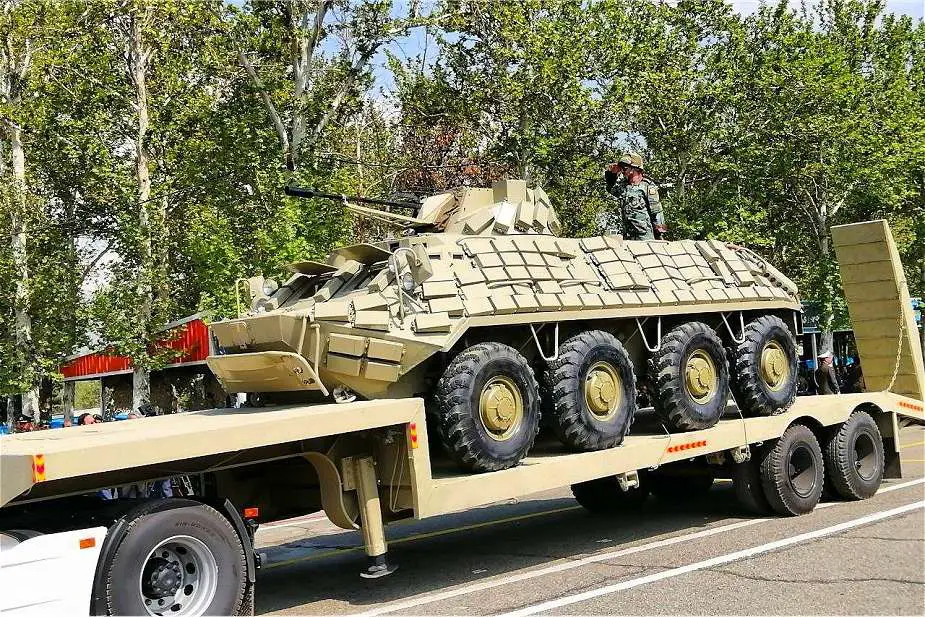Iran Unveils Heidar-7 Upgrade of Soviet-Made BTR-60PB 8x8 Armored Vehicle with 23mm Cannon
Iran continues to advance its defense capabilities by upgrading Soviet-era armored vehicles, showcasing one of its latest developments, the Heidar-7, during the military parade held on April 18, 2024, celebrating the Islamic Republic of Iran Army Day. The Heidar-7, a modernized version of the Soviet-made BTR-60PB, features significant enhancements including a new turret equipped with a 23mm automatic cannon and enhanced protection with Explosive Reactive Armor (ERA) on the turret and hull sides.
Follow Army Recognition on Google News at this link

The new Heidar-7 is based on the Soviet-made BTR-60PB but fitted with a new remotely operated weapon station armed with one 23mm automatic cannon and fitted with ERA armor. (Picture source Iranian Pres Agency)
First introduced in 2017 during an open day of the Iranian defense industry, the Heidar-7 builds on the chassis of the BTR-60PB, which has been in service since 1961. The original turret of the BTR-60PB was replaced with a new remotely operated weapon station armed with one 23mm automatic cannon. The hull and turret of the vehicle are also fitted with ERA (Explosive Reactive Armor) type armor.
The 23mm cannon, akin to the Soviet-made ZU-23-2 anti-aircraft cannon, enables the Heidar-7 to target low-flying aircraft up to 2.5 km away and armored vehicles up to 2 km, enhancing its operational versatility. Additionally, the vehicle boasts a 360-degree traverse and fully stabilized turret, which is controlled from inside the vehicle. The gunner's position is strategically placed at the front right of the hull, opposite the driver, equipped with a display that facilitates all-weather, day-and-night operations.
The design retains the all-welded steel armor of the original BTR-60PB, with both the driver and gunner positioned at the front of the hull, protected by a windscreen covered by a top-hinged flap during combat scenarios. This upgrade reflects Iran's ongoing efforts to bolster its military capabilities amidst enduring international economic sanctions.
Since the overthrow of the Shah in 1979, Iran has seen a significant transformation in its military strategy and capabilities, largely driven by the need to be self-reliant in the face of international sanctions and geopolitical isolation. A key aspect of this transformation has been the acquisition and subsequent domestic adaptation of Russian-origin military equipment, which Iran has increasingly incorporated into its armed forces.
Following the revolution, Iran found itself cut off from its traditional Western suppliers of military hardware. As a result, the country turned to Russia, among other nations, to fill the void. Over the years, Iran has purchased a variety of Russian military equipment, including aircraft, submarines, and air defense systems. These acquisitions have not only bolstered Iran's military capabilities but have also provided a foundation for domestic innovation within the defense sector.
In the last decade, the Iranian defense industry has made significant strides in developing its own technologies and upgrading existing ones. This effort is part of a broader strategy to achieve self-sufficiency and reduce dependence on foreign suppliers. The development of vehicles like the Heidar-7, an advanced version of the Soviet-era BTR-60PB, is a prime example of this initiative. By incorporating modern technologies such as remotely operated weapon stations and explosive reactive armor, Iran is enhancing the capabilities of older platforms to meet current battlefield requirements.
The focus on upgrading and enhancing Russian-origin equipment also reflects Iran's pragmatic approach to utilizing available resources to maintain and expand its military capabilities. By doing so, Iran ensures it can continue to field a capable and modern military force, even as it faces continued economic and military pressures from abroad. This approach not only underpins Iran's defense strategy but also contributes to the growth and sophistication of its domestic defense industry.
Defense News April 2024


























